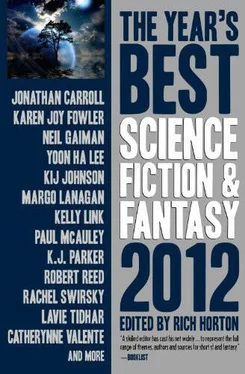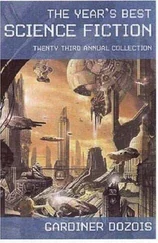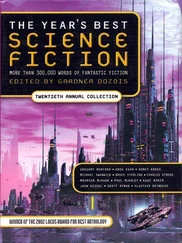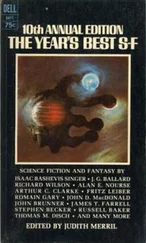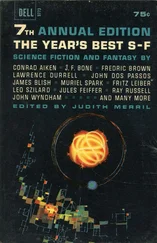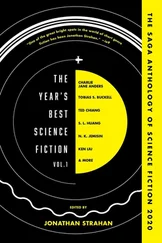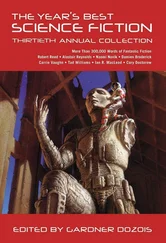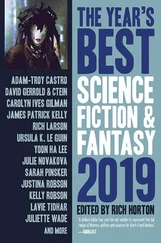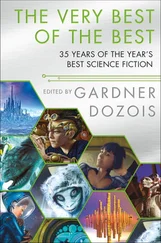THE YEAR’S BEST
SCIENCE FICTION & FANTASY:
2012 EDITION
Edited by Rich Horton
For my daughter Melissa, on the occasion of her graduation (Summa Cum Laude!) from Clemson University.
Introduction, Rich Horton
Ghostweight, Yoon Ha Lee
The Sandal-Bride, Genevieve Valentine
The Adakian Eagle, Bradley Denton
The Sighted Watchmaker, Vylar Kaftan
The Girl Who Ruled Fairyland, For a Little While, Catherynne M. Valente
Walking Stick Fires, Alan DeNiro
Late Bloomer, Suzy McKee Charnas
The Choice, Paul McAuley
East of Furious, Jonathan Carroll
Martian Heart, John Barnes
Pug, Theodora Goss
Rampion, Alexandra Duncan
And Weep Like Alexander, Neil Gaiman
Widows in the World, Gavin J. Grant
Younger Women, Karen Joy Fowler
Canterbury Hollow, Chris Lawson
The Summer People, Kelly Link
Mulberry Boys, Margo Lanagan
The Silver Wind, Nina Allan
Choose Your Own Adventure, Kat Howard
A Small Price to Pay for Birdsong, K.J. Parker
Woman Leaves Room, Robert Reed
My Chivalric Fiasco, George Saunders
The Last Sophia, C.S.E. Cooney
Some of Them Closer, Marissa Lingen
Fields of Gold, Rachel Swirsky
The Smell of Orange Groves, Lavie Tidhar
The Cartographer Wasps and the Anarchist Bees, E. Lily Yu
The Man Who Bridged the Mist, Kij Johnson
Biographies
Recommended Reading
Publication History
About the Editor
Last year I made a point of noticing how many stories—well over half—in this book were from online sources. So it seems natural to revisit the subject this year. Online sources remain strong, though this year only twelve of twenty-nine stories came from them—still a healthy total. (And as I’ve noted before, the distinction can get blurry. Many of the magazines are available electronically—in Kindle editions, for example. And it’s not unusual for an online magazine to publish a print anthology of their stories for a year— Clarkesworld, Lightspeed, and the sadly defunct Zahir all have done this.) Where did the other stories come from? Six came from original anthologies (and one more was published in an original anthology shortly after appearing in a non-genre magazine). Eight came from the traditional genre print magazines—all this year from the so-called “Big Four” SF magazines: Asimov’s, F&SF, Analog, and Interzone. And three came from outside the field: one each from Harper’s, Tin House, and Conjunctions.
What about the other breakdowns of the stories here? Seventeen of the stories are by women (making assumptions about pseudonyms, etc., that may not always hold up, mind you!) Somewhere between thirteen and sixteen—let’s just say half—are science fiction, the rest fantasy. My uncertainty is because a few seem quite ambiguous as to genre. How to treat a case like Kij Johnson’s “The Man Who Bridged the Mist”, set on an unidentified planet (SF?), ruled by an Emperor (fantasy?), about an engineering project (SF?), concerning an implausible seeming river of an unexplained substance called “mist” (fantasy?). I lean towards SF, partly because the story reminded me in some ways of the works of Jack Vance, and had Vance published it it almost certainly would have been considered SF. Or K.J. Parker’s “A Small Price to Pay for Birdsong”? It’s set in what seems vaguely like Earth—indeed Europe—of a few centuries ago, but the geography is not ours. The atmosphere, and the lack of a science fictional maguffin, suggest fantasy, but there’s not a trace of magic, nor of strange beast or monsters (except the human kind). So perhaps one ought to think of it as SF, set in an alternate history for example. (Though it makes no point of any alternate nature to our past.) There a few more stories here set in that SF/fantasy borderland (and not in the so-called “slipstream” region, either). In the end, what does it matter? Categorization is useful in some ways, but often enough it tells us more about the readers and critics doing the sorting than it tells about the writers or the stories. (Indeed I’m sure my brief suggestions about why “The Man Who Bridged the Mist” might be fantasy or SF say plenty about me.)
As for the length breakdowns, last year I noted a relatively low number of novelettes in this book. I thought that a statistical fluke (and reflective of an overall weakish year at that length in the field), and I think this year bears that judgment out—novelettes are back in their usual numbers, pretty much—this year nine stories are between 7500 and 17500 words, the (somewhat artificial) SFWA range for that length. I include four novellas. I could have included several more novellas given the space—but they do fill up a book fast! So I strongly recommend you seek out stories like Catherynne M. Valente’s Silently and Very Fast,K.J. Parker’s Blue and Gold,Lavie Tidhar’s Jesus and the Eightfold Path,Carolyn Ives Gilman’s “The Ice Owl,” Elizabeth Hand’s “Near Zennor,” Robert Reed’s “The Ants of Flanders,” Kristin Livdahl’s A Brood of Foxes,and Mary Robinette Kowal’s “Kiss Me Twice.” Indeed, we have included a generous list of recommended reading in the back of the book—this year as every year, there was an abundance of riches to choose from, many stories I couldn’t fit in this book but which deserve a wider audience.
One of the things I like to keep track of as well is how many newer writers are showing up in my books. This year twelve writers are making their first appearance in one of my anthologies, but that doesn’t mean they are new, of course. I’m fortunate to now be able to feature such brilliant writers as Jonathan Carroll, Bradley Denton, and Suzy McKee Charnas for the first time, but their reputations have long been established. There are also a few writers appearing here for the first time who have been doing exciting work for several years—I’m a bit late to the party, perhaps, with Lavie Tidhar, certainly, and with Nina Allan, who has been doing impressive work, mostly in UK and Irish publications, for a few years. Alan de Niro, Gavin Grant, Chris Lawson, Vylar Kaftan, and Marissa Lingen are all also writers I’ve had my eye on for a few years. (Speaking of the perils of gender identification, I recall that I publicly listed Lavie Tidhar as a woman and Vylar Kaftan as a man in discussing a publication they both appeared in a few years ago—at least my aggregate counts were correct!) And I’m particularly pleased to have two even newer writers in the book: E. Lily Yu (still in college as far as I know!) and Kat Howard. And I should probably also mention that some of the writers I’ve already anthologized twice are quite young, or at any rate quite new to publishing, such as C.S.E. Cooney, Genevieve Valentine, and Alexandra Duncan. The field remains in good hands.
Commercially, there were some shifts in the short fiction field. One of the major magazines, Realms of Fantasy, died for the third straight year, and this time it seems likely to stay dead. Realms of Fantasy was an ornament to our genre for some eighteen years, with a remarkably consistent vision transmitted by a single editor, Shawna McCarthy, and it will be missed. Another fine small magazine also died: Zahir, edited by Sheryl Tempchin, which had transitioned online in 2010 after several years of very attractive print issues. And Fantasy Magazine was taken over by Lightspeed editor John Joseph Adams, and as of 2012 the two sites will have been merged under the Lightspeed title. Fantasy continued to publish excellent work under Adams, and the combined Lightspeed site promises to be one of the very best SF/fantasy destinations.
Читать дальше
